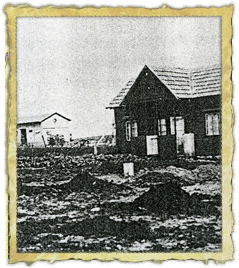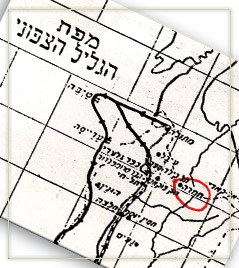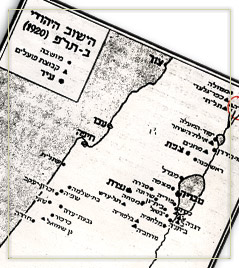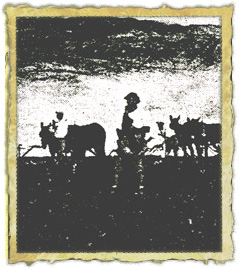Hamra - the first Moshav ovdim (a workers cooperative settlement) in Eretz Yisrael The Land of Israel)
Hamra, one of the settlements' cornerstones especially at the Upper Galilee. Four Jewish settlements were established at the Upper Galilee: Metula (1898), Hamra (1919), Kfar Giladi (by the HaShomer members - 1916) and Tel Hai (1907).
Hamra can be regarded as a good example for the unimaginable pioneering spirit of those days, the time of The Second Aliyah. Natan Haruvi was the driving force in this group, involved in the supply of weapons, warm clothing and products to the northern settlements. After Shneor Shaposhnik died of his injuries in Tel Hai, Natan Haruvi was sent by the settlements to the officials in Jaffa. At that time, mid December, the settlers in Hamra considered to abandon the place due to the Arab riots.
In 1919, a group of laborers including greengrocers, farmers and planters decided to establish a Moshav Ovdim (a workers cooperative settlement). The Jewish Colonization Association (JCA) allocated part of the lands of Kfar Giladi to a group of thirteen men and women to settle in Hamra. At a meeting that took place in Merhavia, the following decisions were made:
The land will remain the property of The Jewish National Fund.
The required credit for settlement will be based on mutual guarantee for a fixed number of years.
The farm will be mixed
Each member will receive forty to fifty dunams including some irrigated dunams.
The Moshav relies on cooperative purchasing of supplies and marketing of produce; the family or household is, however, the basic unit of production and consumption
6_3_1 Haruvi Archive
Two settlements were established in Hamra: the first in 1917 later renamed Kfar Giladi; the second in 1919 later ruined during the Battle of Tel Hai. This latter group established in 1922 Kfar Tivon.
A group of thirteen men and one woman settled on the Hamra hill in October, 1919.
They built two wooden huts and dreamt about establishing a Moshav Ovdim enough for a hundred families. The settlers asked for weapons for their safety as they were facing a difficult security situation.
On Dec. 7th, shots being fired from a distance in the direction of two members from Hamra pumping water at the Hasbani river, were reported.
After a few apparently quiet days, armed Bedouin where again in the area of Hamra.
Two members from Hamra were attacked by Arabs while traveling from Hamra to Kfar Giladi. The Arabs robbed their horse which was loaded with a sack of flour.
On Saturday, Dec.13th, following Shneur Shaposhnik's death, it was Meir Kozlovsky from Kfar Giladi and Natan Zsolt (Zehavi) from Tel Hai, who reported the event and asked for help form the members in Ayelet HaShahar and Mahanayim. Reinforcement of four people
finally arrived.
Hamra, about three kilometers form Kfar Gilade, was the most vulnerable and weakest point in the area. The only two huts built there were surrounded with a moat. They had no fencing materials.
The Bedouins were passing there on their way from the Golan Heights to the Hula and to the Christian villages north of Metula.
The Bedouins used to gather at Az-Zuq al-Fawqani, which was on the way form Hamra to Kfar Giladi.
On Dec. 15th, the Bedouins rampaged in the Christian villages near the settlements,
The members of Hamra decided to take their belongings to Metula, thus leaving the place
with three guards.
Januray 1st, Hamra members carried out their plan and after confronting the Bedouins once again, they all left for Metula. Only David Dobrinsky left for Tel Hai.
After leaving Hamra, there were twenty five people in Kfar Giladi and eighteen in Tel Hai. The members that left Hamra managed to take along their weapons, some animals and a few belongings. When a few member returned to Hamra to find some more possessions, they were caught by the Arabs who were shooting at them. Only later on they were released, but that afternoon the Arabs set the huts in Hamra on fire.
On January 4th, some members from Hamra met in Metula with Avraham Herzfeld, from The Agricultural Laborers' Union Agricultural. The purpose of this meeting was to discuss the future of the settlement in Hamra. The majority were of the opinion that due to Hamra's bad strategic situation, the members will be better off in Kfar Giladi. The meeting was interrupted by the notification that Hamra was on fire.
On January 3rd, French troops camped near Metula, getting ready to attack the villages in the North area of the Hula the following day. These military forces were based in Metula, but
the front headquarters were approaching the huts of Hamra. The French stationed cannons and machine guns, firing the villages in the Hula and the sloped of the Golan Heights for long hours, causing the residents to escape to the mountains. The French force, after having used most of their ammunition, were taking off to Metula. In the meantime, the Bedouins set the huts in Hamra on fire. When the French soldiers arrived at Abil al-Qamh and in Metula, the Bedouins attacked them, fighting them to death.
When Avraham arrived in Metula he found out that the members from Hamra were living at the end of the street, in the house near the greengrocers group. There, Avraham met Natan Haruvi, who has just returned from Jerusalem with provisions to the Galilee. Haruvi told Avraham about the events concerning Hamra.
|













